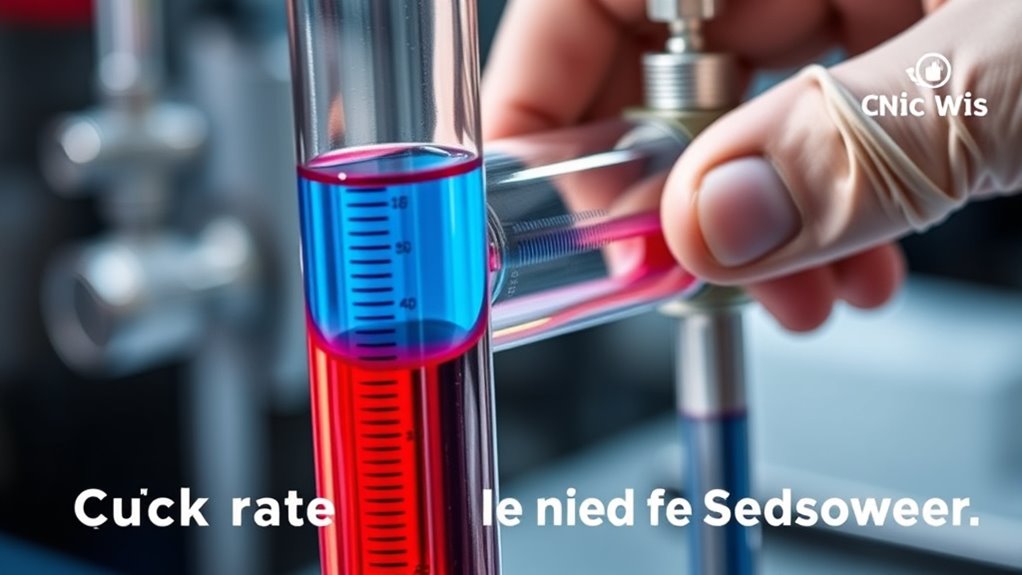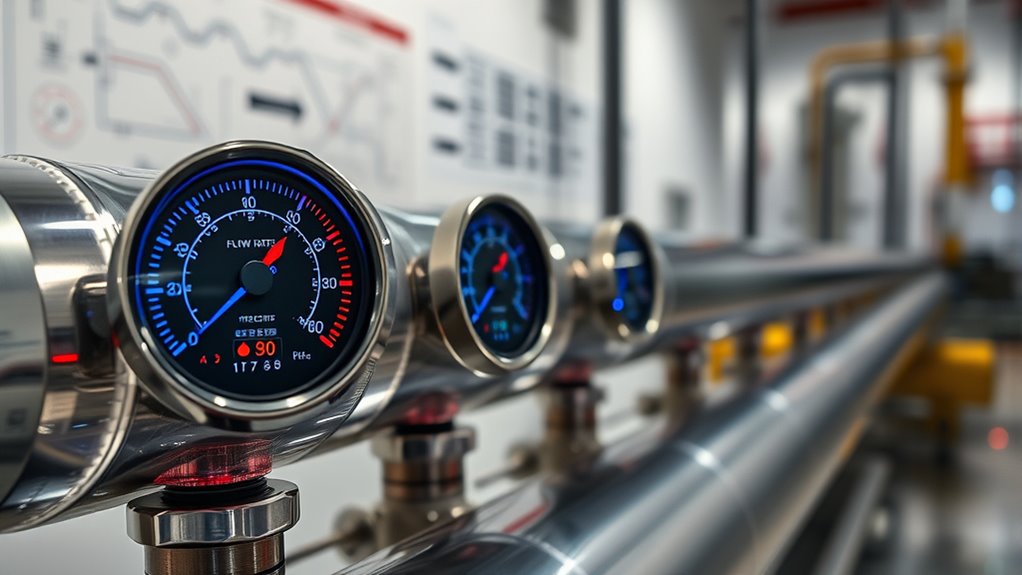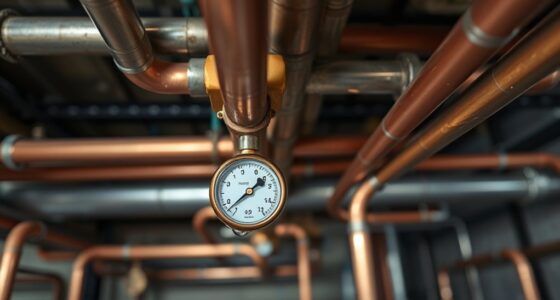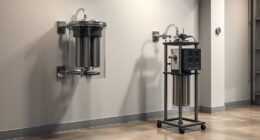To quickly grasp flow rate and pressure drop basics, start by understanding that flow rate shows how much fluid moves through a system over time, measurable with flow meters or volume calculations. Then, learn how pressure drops occur due to factors like pipe size or blockages, which you can analyze using simple formulas like Darcy-Weisbach. By mastering these concepts, you’ll spot inefficiencies easily; explore further to access more detailed insights.
Key Takeaways
- Understand that flow rate measures fluid volume over time; use flow meters for quick, real-time data.
- Measure pressure at multiple points to identify pressure drops and locate system inefficiencies.
- Use the Darcy-Weisbach equation to estimate pressure loss due to pipe friction quickly.
- Regularly calibrate flow meters and pressure sensors to ensure accurate, reliable readings.
- Control flow rate to optimize system performance, prevent blockages, and improve overall efficiency.
Understanding Flow Rate and Its Measurement

Understanding flow rate and how to measure it is essential for maximizing fluid systems. In fluid dynamics, flow rate indicates how much fluid passes through a system over a specific period. To accurately measure it, you need to choose the right measurement techniques, such as using flow meters or volumetric methods. Flow meters, like turbine or electromagnetic types, provide real-time data and help you monitor system performance. Precise measurement techniques allow you to identify inefficiencies and ensure consistent operation. By understanding flow rate, you can make informed decisions to improve system efficiency, reduce energy costs, and prevent issues like pressure drops or blockages. Mastering measurement methods is the first step toward fine-tuning your fluid systems for peak performance. Proper maintenance and regular filter replacement are also critical for maintaining optimal flow and air quality in filtration systems.
Calculating and Analyzing Pressure Drop in Systems

Calculating and analyzing pressure drop helps you identify how fluid flow is affected as it moves through different system components. By understanding pressure drop, you can evaluate pump efficiency and spot issues caused by pipe friction. Key factors include:
- Measuring pressure at various points to determine where losses occur
- Using the Darcy-Weisbach equation to quantify pipe friction effects
- Comparing pressure drop with flow rate to optimize system performance
- Recognizing high pressure drops that indicate potential blockages or undersized pipes
- Appraising how pipe material and diameter influence overall pressure loss
- Considering projector technology factors that can impact flow and pressure in cooling or ventilation systems
This analysis helps improve pump efficiency by reducing unnecessary pressure drops and ensures your system runs smoothly without excessive energy use. Regular checks allow you to fine-tune your setup for maximum performance.
Frequently Asked Questions
How Do Temperature Variations Affect Flow Rate Measurements?
Temperature fluctuation can greatly impact your flow rate measurements by altering fluid viscosity and pressure. When temperatures rise, fluid becomes less viscous, increasing flow rate; cooler temperatures do the opposite. These variations can reduce measurement accuracy if you don’t account for temperature effects. To guarantee precise results, always monitor and compensate for temperature changes during flow rate assessments. This way, you maintain consistent measurement accuracy regardless of temperature fluctuations.
What Are Common Mistakes When Calculating Pressure Drop?
You often make pressure miscalculations when you forget to account for measurement errors or overlook factors like pipe roughness and installation conditions. Common mistakes include using inconsistent units, neglecting to calibrate instruments regularly, and ignoring temperature effects that can skew readings. To avoid these errors, double-check your data, use proper calibration, and verify your measurement setup is accurate. This way, your pressure drop calculations become more reliable and precise.
How Can Quick Wins Improve System Efficiency Instantly?
You can instantly boost system efficiency through quick wins by focusing on system calibration and flow optimization. Proper calibration guarantees your measurements are accurate, reducing errors and improving performance. Streamlining flow paths minimizes pressure drops, enhancing flow rates without extra energy. These simple adjustments lead to immediate improvements, saving time and costs while optimizing your system’s overall operation. Implementing these steps helps you realize quick, impactful gains.
Are There Tools Recommended for Beginners to Measure Flow and Pressure?
Think of tools like pressure gauges and flow meters as your trusted compass on a journey. For beginners, these devices are straightforward to use and essential for accurate measurements. Pressure gauges help you monitor pressure drops, while flow meters track flow rates. Both are readily available, user-friendly, and affordable, making them perfect starting points to understand your system’s health and optimize performance without needing advanced technical skills.
How Do Pipe Material and Diameter Influence Pressure Drop?
Pipe material and diameter effects markedly influence pressure drop. Smooth materials like copper reduce friction, lowering pressure loss, while rougher ones like cast iron increase it. Larger diameters decrease pressure drop because they allow more flow with less resistance, whereas smaller diameters increase it, making flow harder. By choosing appropriate materials and pipe sizes, you can effectively manage pressure drops, ensuring your system runs efficiently and reliably.
Conclusion
Now that you grasp flow rate and pressure drop, you’re just a step away from mastering system efficiency. But remember, these quick wins are only the beginning—small adjustments can hide bigger surprises. Will your next tweak unleash hidden potential or reveal unseen issues? Stay curious, keep experimenting, and embrace the challenge. Because in this game, understanding the flow today could mean breakthroughs tomorrow—are you ready to discover what’s truly possible?









